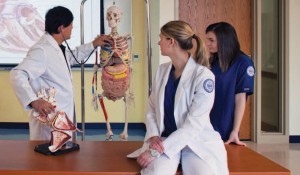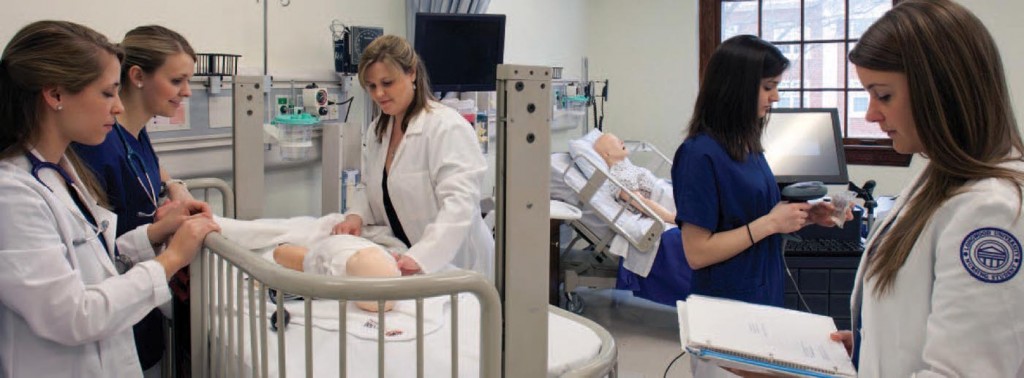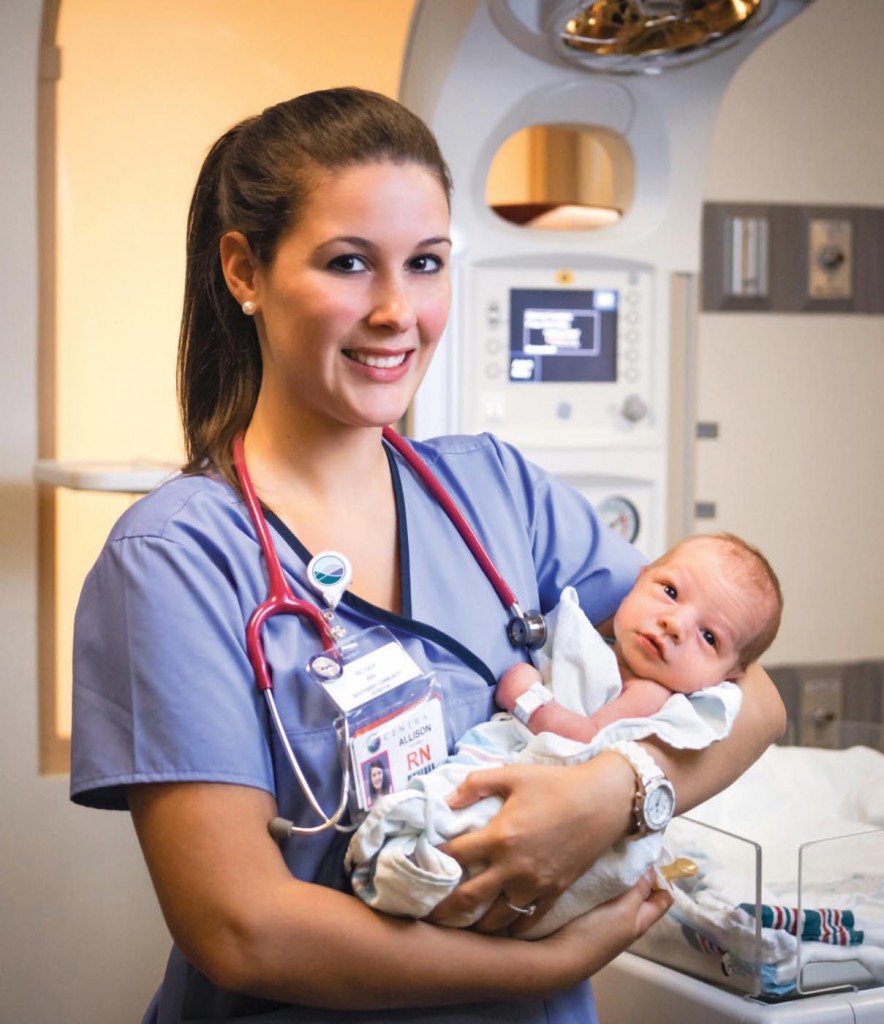
Marc Bein ’13 works as a scrub nurse in the operating rooms of three Richmond hospitals affiliated with HCA Virginia.
First class of nurses has impact in emergency rooms, operating rooms and birthing centers throughout the Commonwealth
Helping to deliver babies, taking care of gunshot victims and assisting in life-saving surgeries are just a few of the experiences on tap for Longwood’s first nursing graduates, who are beginning their careers after completing their Bachelor of Science in Nursing degrees in May.
“They’ll all have jobs,” Melody Eaton, chair of the nursing department, said in early June. “Nursing remains one of the top growth professions. There is a world of opportunity for the BSN-prepared nurse.”
Among the 25 members of the inaugural class are those working in hospital emergency rooms, operating rooms, birthing centers,medical-surgical units and other departments. Fourteen of them graduated with jobs, and most of the others quickly landed positions in health care settings throughout Virginia and at least one hospital in Maryland.
Stacy Bolt ’13 was urged to become a nurse by a high-school teacher who told her she “had that spark.” She followed his advice and now is part of Longwood history.

“I was all set to go to High Point University— I had paid my deposit—but then I heard a radio ad about Longwood’s nursing program,” said Bolt, who works in the emergency room of Centra Southside Community Hospital (CSCH) in Farmville, her hometown. I was very fortunate that things turned out as they did. I couldn’t have asked for anything better.”
Bolt and the other Longwood nurses are helping to fill a serious need.
Longwood’s 10,000-square-foot simulation center includes two clinical skill labs, three patient simulator labs, a health assessment lab, a mother-infant simulation lab, conference/debriefing rooms, patient examination rooms and a home-care learning center.
In Virginia alone, the nursing shortage is projected to reach 36 percent by 2020, according to the Virginia Department of Health, exacerbated by an aging population and new patients expected to enter the medical system through the Affordable Care Act. That legislation also will prompt the need for more nurses to “coordinate care and assist with patient/client navigation through a very complicated health care system,” said Eaton. Southside Virginia is being hit with a double whammy: The nursing shortage is even greater than in other parts of the state while the need for health care providers is even greater due to the higher incidence of chronic diseases in the Southside population such as diabetes, hypertension and cardiovascular disease.
Meanwhile, there is a nationwide push for more nurses to have BSN degrees. In its landmark report “The Future of Nursing,” Issued in October 2010, the Institute of Medicine recommended increasing the number of baccalaureate prepared nurses in the workforce to 80 percent by 2020. The number currently is less than 30 percent.
“Most hospitals are now requiring that RNs have a BSN,” said Eaton.

The 2013 graduates were among 37 freshmen who began their studies when the nursing program was launched in fall 2009. Enrollment grew to 140 in 2012-13, including 42 freshmen, which is capacity. The program has nine full-time faculty, three permanent part-time faculty, and other part-time and adjunct faculty.
“In considering growth, we always have to consider three things—the capacity of the school, the faculty-student radio and the clinical sites,” said Eaton. “We have to meet the community’s needs without overwhelming the clinical sites. A lot of nursing programs jockey for clinical sites.”

Amber Hare ’13 is working in cardiac telemetry at Bon Secours Mary Immaculate Hospital in Newport News.
In addition to beginning their professional careers, the Longwood nurses have been taking their board licensure examinations, passage of which enables them to work as licensed RNs. Even before graduating in May, they had gotten a taste of their profession. Their preparation included two major clinical experiences—a 280- hour internship during their last semester and a 56-hour externship in the summer after their junior year. Several are working in jobs that aren’t for the faint of heart.
I could not have asked for a better education. The professors and staff were more than just teachers to the students—they were our mentors and, more importantly, our friends. They wanted all of us to succeed.
ALLISON MITCHELL ’13
NURSE, CENTRA SOUTHSIDE COMMUNITY HOSPITAL BIRTHING CENTER
Kenly Walston ’13, who plans to specialize in emergency medicine, is working at the Prince George’s (Md.) Hospital Center, a shock trauma facility. “I’m sure I’ll see a ton of shootings, stabbings and car accidents,” she said shortly before starting. In her internship in the emergency department at Henrico Doctors’ Hospital in Richmond, her patients included heart attack and stroke victims.
Bolt, who wants to become a certified trauma nurse, has been working in CSCH’s emergency room for more than a year, first on a paid, part-time basis since finishing her externship in the hospital’s intensive care unit in July 2012. She became an official, full-time ER nurse in mid-July. “I’ve seen crush injuries, motor vehicle accidents, strokes and heart attacks,” she said.
Brittany Hess ’13 works in trauma and orthopedics at the University of Virginia Medical Center in Charlottesville. “The trauma part of my job includes car accident patients, traumatic brain injuries and people with work-related injuries, many of them in construction,” said Hess, who plans to work in pediatrics and trauma.
Marc Bein is working in the operating rooms of the three Richmond hospitals—Henrico Doctors, Chippenham and Johnston-Willis— affiliated with HCA Virginia. “I’m a scrub nurse. I’m with patients in surgery, passing the instruments and assisting the surgeons,” said Bein, who after six months will be assigned to whichever hospital has the greatest need. He wants to become a registered nurse first assistant, who, he said, “doesn’t just hand the instruments to the surgeon but assists with the surgery.”

Allison Mitchell ’13 decided to stay in Farmville, working in Centra Southside Community Hospital’s birthing center, where she takes care of women in labor and newborn babies.
Allison Mitchell ’13 is another graduate who decided to stay in Farmville, working in Centra Southside’s birthing center, where she takes care of women in labor and newborn babies. “I provide care during the labor process, assisting in deliveries, providing newborn care and caring for the mother after the delivery until she is discharged from the hospital. The nurses in the birthing center do it all,” she said.
Several graduates are working in the hospitals where they interned. In addition to Mitchell and Bolt, Molly Dibble ’13 and Melissa Nagle ’13 converted internships to full-time jobs. Dibble is in the nurse residency program at Mary Washington Hospital in Fredericksburg. She turned down three other job offers before accepting one from Mary Washington, in critical care nursing (her internship was in surgical ICU). Nagle signed on for a position in the medical-surgical unit at St. Francis Medical Center in Midlothian. She wants to specialize in wound-care nursing.
Eaton compared the internship to a capstone course. “The students are paired with a practicing registered nurse, and they work in unison to complete 280 practice hours, usually in a hospital. They also have classes their last semester.”
Internships are just one of the strong points that qualified the nursing program for the academic world’s most important endorsement: accreditation. The program was fully accredited by the Commission on Collegiate Nursing Education in May, retroactive to the site visit in November 2012.
“We had only positive feedback and were rated ‘exceptional’ with our simulation center and our learning environments,” said Eaton. The accrediting body found no problems, which is something I’ve never seen before. With every internship, we’ve had exceptionally positive feedback on our students. The curriculum has been fully developed—we have gone through all of the courses at least once and some several times.We have an excellent base with our program.”
The 10,000-square-foot simulation center, supported by a major donation from Farmville physician Dr. Edward I. Gordon and completed in May 2012, is widely praised. Located on the third floor of Stevens Hall, the former science building, the center includes two clinical skill labs, three patient simulator labs, a health assessment lab, a mother-infant simulation lab, conference/debriefing rooms, patient examination rooms and a home-care learning center.
“It’s one of the largest clinical simulation centers in Virginia,” said Cindy Crews, its director. We utilize it and integrate it into every clinical course. Some nursing programs have a simulation center but don’t use it.”
The simulations, which take 30 minutes to an hour and are done for two to four students, are videotaped so the students can view and critique their performance. “In one of our last senior simulations during the spring semester, we had volunteers from the theatre program stand in as patients and family members. They had a ball,” said Crews.
Mitchell, one of the graduates who stayed in Farmville, called the simulation center “essential to our education. It allowed us to provide reallife nursing care in a safe setting while learning the importance of communicating and collaborating with other health care members. This prepared us for our clinicals in the hospital and the community.”
Longwood’s BSN program, the only BSN offered by a state school within a 60-mile radius of Farmville, uses a community-based curriculum. “We’re trying, through outreach, to integrate our students into the Farmville community, which is the way health care is moving—away from hospitals and out into the community,” said Eaton. “We want students to care about the community and to consider staying here after graduating.”
In another difference, students are admitted directly into the program as freshmen, which enables them to begin their clinical practice and gain valuable experience before their peers at other schools. Students in most nursing programs take a year of general education courses as freshmen, apply and are accepted to nursing as sophomores, and begin their nursing studies as juniors.
The members of the inaugural nursing class have nothing but good things to say about their preparation.
“I could not have asked for a better education,” said Mitchell. “The professors and staff were more than just teachers to the students— they were our mentors and, more importantly, our friends. They wanted all of us to succeed.”
Hess was also accepted into Virginia Commonwealth University’s nursing school. “I chose Longwood’s program because I thought it was neat to be in the first class. Also, I figured I’d get smaller class sizes and more one-on-one education. My experience turned out to be everything I hoped for, and more.”
Amber Hare ’13, who is working in cardiac telemetry at Bon Secours Mary Immaculate Hospital in Newport News, was a double major. She started in fall 2008 as a biology major, then added nursing when the program started the next year. “I thought nursing was perfect for me. I had always thought about going into the medical field, but doctors often walk into a patient’s room and spend only two seconds with them. I’m a people person, so nursing is a perfect mixture of medicine and spending time with your patients.”
As the first president of Longwood’s chapter of the Virginia Nursing Students’ Association, a post she held for all but her last semester, Dibble helped write the chapter’s constitution and bylaws. “The program was great in providing opportunities for leadership and in encouraging students to become citizen leaders,” she said. “The program also was good in providing clinical sites in various community settings, including health departments and local schools.”
Three of the recent nursing graduates— Kelli Baker, Bein and Nagle—took advantage of international citizen leadership opportunities at Longwood. In a weeklong medical study trip to the Dominican Republic in January, Bein
did triage at a health clinic and later, working alongside Longwood Student Health andWellness Center Director Margo Potts, helped assess patients and make recommendations. Baker and Nagle participated in a medical mission trip to Honduras in June 2012 in which they provided basic care at five remote mountain villages. Over five days. The trip was initiated by Hadley Sporbert, instructor in the nursing program, who was accompanied by one of her colleagues on the nursing faculty, April Shular.
“Student outcomes are what matter, and our graduates are well-prepared as new nurses,” said Eaton.
By: Kent Booty
